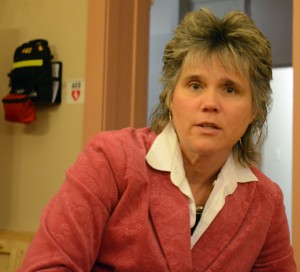By Jennifer Bowman
Courtesy of Rural Hastings Advocate [1]

(Belleville, Ont. Dec. 1, 2011) Kim Charlebois, director of the Sexual Assault Centre for Quinte and District, said the waiting list at the centre peaked in August, but that doesn't mean more people are being sexually assaulted. Photo by Jennifer Bowman
It looks like the Quinte region is an increasingly dangerous place for women to live.
Sexual assaults have tripled in Belleville since last year, according to Belleville police statistics.
The local sexual assault centre has hired more staff to help reduce the longest waiting list it’s ever had.
But the statistics might just be another numbers game.
In August, both the Sexual Assault Centre for Quinte and District as well as Belleville police reported skyrocketing numbers of reported sexual assaults. Both agree that doesn’t mean sexual assaults are more frequent.
Sexual assault is a crime that often goes unreported, making it difficult to find out how big the problem really is, said Belleville Police Chief Cory McMullan.
According to the National Clearinghouse on Family Violence, one in three women and one in six men are sexually assaulted in Canada sometime in their lives. That means in a family with three daughters, statistically one of them will be a victim of sexual assault at some point in their life.
The numbers could be up in the Belleville area because more people are aware of sexual assault and are confident enough to speak about it, said McMullan.
Tragic events in the Quinte area over the past two years have heightened that awareness: events such as the heinous sexual assaults and murders committed by Russell Williams, Belleville’s police chief saying she was a victim of domestic violence, and the sexual assault involving six men and one woman in Belleville this summer.
The sexual assault centre received more calls during that time, said Charlebois. But not all the calls were recent incidents.
Charlebois said many of the people who come to the centre are dealing with past incidents of sexual assault.
The centre’s waiting list isn’t a long line-up of people who have recently been sexually assaulted. For many of them, it is a deep ugly scar of the past that haunts and influences their lives today.
Both the sexual assault centre and police statistics are increasing, but they will never be exactly the same. That’s because not everyone reports to the same agency. Some people are more comfortable speaking to the sexual assault centre; others go to the police; still others go to the hospital. Sometimes they will contact more than one agency.
But just contacting one agency takes more courage or requires a greater risk than some women are willing to take.
There is a great deal of shame attached to sexual assault, said Charlebois.
That’s especially true for rural areas, according to a study by Canada’s Department of Justice.
The study says the difficulties rural women face when dealing with sexual assault are compounded, not only by the fact that help is often far away and they have limited information and transportation, but also by prevailing attitudes. The study, which was done in six rural areas across Ontario, showed how stereotypes and community views on domestic violence greatly affected how women responded.
Women are reluctant to ask for help because of the traditional male and female roles, the study said. They don’t have a sense of anonymity because everybody knows everybody and sexual assault becomes the source of gossip. At the same time, many in the community know about incidents of sexual abuse, but don’t do anything about it.
There are also safety issues because of delayed response times, distance, and location.
Statistics on rural incidents of sexual assault are not well documented, but the sexual assault centre deals with rural and urban cases.
They deal with them the same way, said Charelbois. They don’t ask whether they are from a rural or urban area.
The increasing numbers in reported sexual assaults may be a good thing. The statistics don’t tell us whether or not more people are being sexually assaulted. What the numbers do tell us is more people are reaching out and getting help.